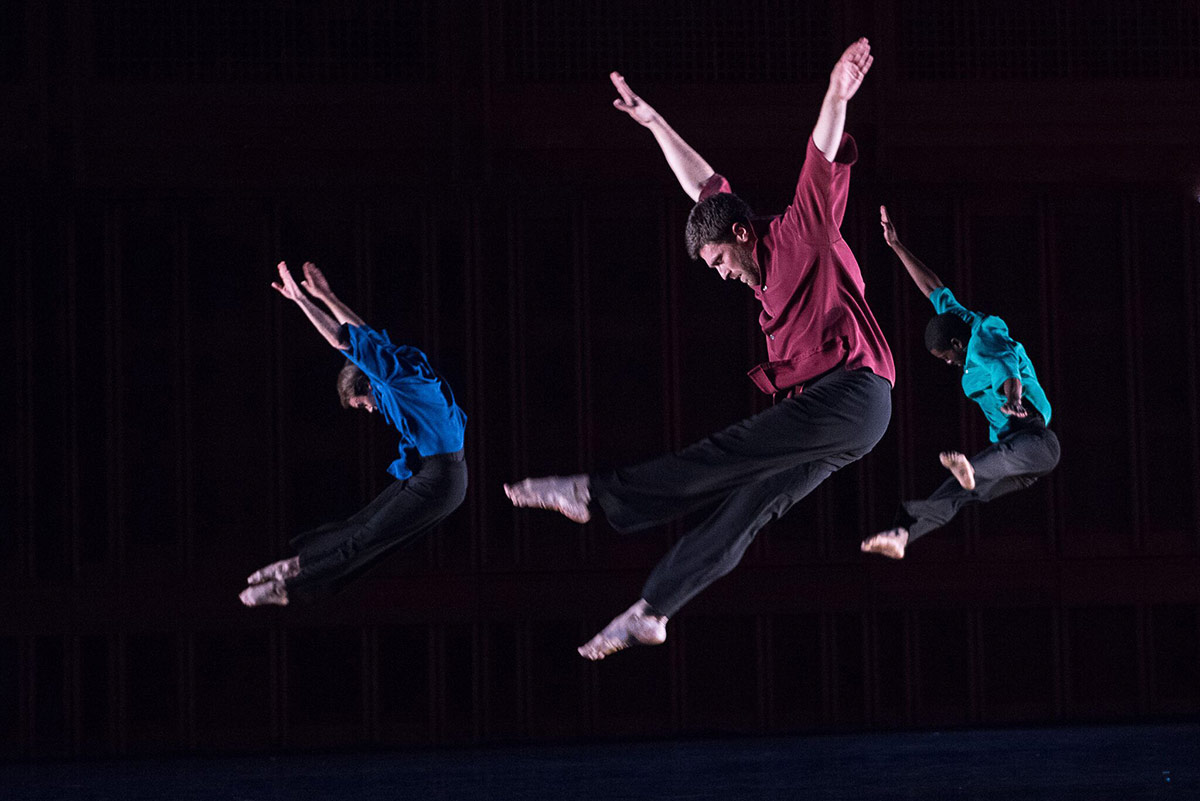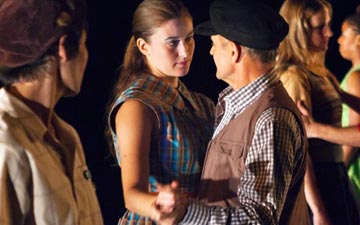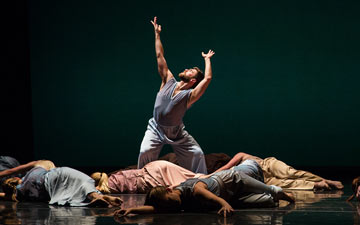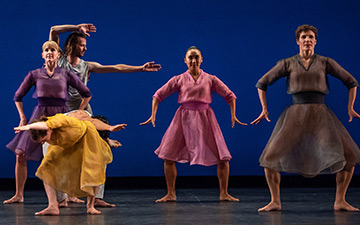
© Hilary Schwab. (Click image for larger version)
Mark Morris Dance Group
Lou 100: In Honor of the Divine Mr. Harrison: Pacific, Numerator, Serenade, Grand Duo
★★★★✰
New York, Mark Morris Dance Center
25 April 2018
markmorrisdancegroup.org
Dancing at Home
In New York, the Mark Morris Dance Group (MMDG) tends to perform in large theatres, as part of high-prestige festivals like Mostly Mozart and the White Light Festival, so we sometimes forget that the company is, at heart, a modestly-sized troupe that performs as many small, intimate dances as big, spectacular ones. Unlike most other modern-dance troupes its size, however, it has its own building, with a busy school and light-filled rehearsal spaces and, even better, a blackbox theatre on the top floor. In recent years, they’ve held seasons there, yet another reason to be happy about living in New York.
This week and next, MMDG is performing two programs at home, of which I caught the first. The second seems in some ways even more interesting, as it includes a new work, Little Britten, as well as One Charming Night, an older dance that has never been performed by anyone but Morris – but will now go to Dallas McMurray – and a cameo by the maestro himself, in From Old Seville. I’ve seen it once before, some years back, and let me tell you, Morris’s footwork is impressive; as a kid in Seattle, he was a serious flamenco student.
This first program is a tribute to Lou Harrison, the Oregonian composer who was also a friend of Morris’s, and whose centenary year this is. There are four works on view. One, Serenade, is a solo, premiered five years ago. Another, Pacific, was originally made for San Francisco Ballet, in 1995; it used to include pointework, but has been adapted for the MMDG dancers. Grand Duo, from 1993, is one of Morris’s most popular, and rousing pieces. The finale is memorable: a round dance in which the dancers slap their thighs, kick their calves, and stomp to difficult-to-count rhythms, creating a sense of excitement verging on euphoria. The most recent work, Numerator, is from last year; this is its New York début. The all-male sextet revolves around themes of friendship and love, ending with a group hug. It may sound corny, but it’s saved by that note of objectivity and straightforwardness that characterizes practically all of Morris’s work.

© Stephanie Berger. (Click image for larger version)
The dancers are direct, no-nonsense, and so in tune with the music that the movement and accompanying rhythms and phrases seem to emanate as much from their bodies as they do from the instruments. The music was live, a cardinal rule for Morris; the musicians occupied a corner to the left of the performance space or, on one occasion, appeared onstage. The small, shifting ensemble included Colin Fowler, music director for the ensemble, bending the piano to his will, particularly in Harrison’s Grand Duo for Violin and Piano, in which he used the keyboard almost as a percussion instrument, sounding out note clusters with a wooden block. Robert Belinic’s guitar-playing in Serenade was warm, crisp, well-defined. Belinic and the percussionist were joined on castanets by Morris, playing with complete authority. (Another leftover from his flamenco training.) Music, as he often says, is at the center of everything he does.

© Stephanie Berger. (Click image for larger version)
Three of the four pieces had Eastern influences, mainly from Gamelan – the percussion, bell, and xylophone musical style of Java, Bali, and Indonesia – in which Harrison had a vivid interest. Serenade was more a l’espagnole. In every piece, Morris responds to the atmosphere of the music as well as its structure. His interpretation is never completely literal, but it borrows colors and flavors from the various traditions he has studied. The arms in the opening number of Serenade recalled the curlicues we associate with flamenco. Later, she danced with a fan. One can call it “appropriation,” to use that fashionable term, or simply an example of Morris’s far-flung vocabulary and interests. After all, this is the man who made an entire twenty-minute solo to an Indian Raga, O Rangasaye, in 1984, which he danced in a folded dhoti.

© Christopher Duggan. (Click image for larger version)
At one point in Numerator, the dancers perform to the sound of bowls being struck by a mallet. The piece begins with a line of men who enter, one by one, slithering on the floor, then crawling, and finally walking erect. The progression ends with a beautiful arabesque. There it is, evolution illustrated through one quietly executed gesture. Then they perform a rhythmic rag doll dance, loose but tightly structured – there is never a sense of randomness in Morris’s work. And finally, they walk hand in hand, like friends or lovers, flicking their free hand as if to accent a point in conversation.
Pacific, originally made for a ballet company, is more expansive; arms are often held out wide, with the chest open. Dancers glide across the stage like birds flying above the surface of an expanse of water. Everyone wears a long skirt, by Martin Pakledinaz, and the men are shirtless. As in Mozart Dances, the women move with even more groundedness and gravity than the men. But atypically for Morris, the dance includes an extended male-female pas de deux, and it’s a beauty. Noah Vinson and Sarah Haarmann move in clear, luminous shapes, reaching, lunging, turning with a thrilling expansiveness and purposefulness. Harmaan – a petit dancer with clean, strong lines – is particularly eye-catching. Her focus is riveting.

© Hilary Schwab. (Click image for larger version)
This sense of purpose comes through in all the dancing. Not a movement is wasted, nor is anything thrown away. The energy and focus is all absorbed into the intention of each step rather than projected outward as a form of ego or “personality.” It’s one of the most striking characteristics of the Mark Morris Dance Group. A common sense of focus, an alertness to the music and to each other. The dancers are present; the moment is electric, and feels un-repeatable. One is reminded of that apocryphal Balanchine dictum: “there is only now.”
Performances at the Mark Morris Dance Center run through May 6.

















You must be logged in to post a comment.